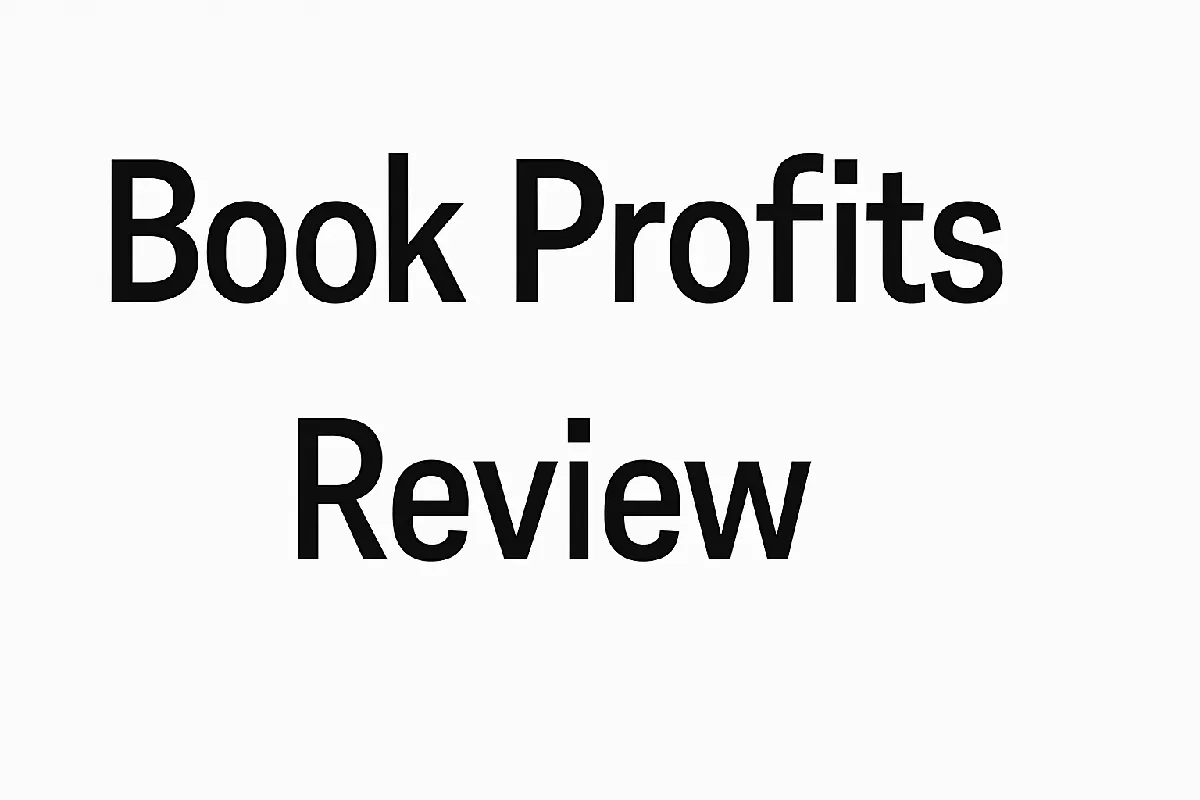Book Profits Review - Is Luke Sample's Program Worth it?
Welcome to this Book Profits review. When I first looked into Luke Sample’s program, the idea sounded different from most e-commerce systems I had tried before.
Instead of dropshipping or running ads, this one focused on book arbitrage — buying underpriced books and reselling them on Amazon at a profit.

Luke and his business partner Jon Shugart positioned it as a structured system with software to find profitable titles, training to guide the process, and promises of reliable returns if followed consistently.
At first glance, the approach seemed straightforward. Amazon’s marketplace is massive, and there are always books moving through it.
What drew me in was the claim that their software could identify gaps automatically, cutting down on the hours of manual research that arbitrage usually requires.
Combined with their guarantees and mentorship angle, it was framed as a safer and more efficient way to build a business.
But digging deeper, the reality was less polished. Some students reported seeing profits, while others struggled with low margins and slow results.
I noticed complaints about refunds not being honored and about the constant rebranding of the program under different names.
The upfront cost — in the thousands — also made it clear that this wasn’t just a casual experiment.
Pros
– Unique business model outside of typical dropshipping – Software tools save time sourcing books – Training provides structure and step-by-step guidance
Cons
– High upfront and ongoing costs – Mixed track record with refunds and guarantees – Margins can be thin, making scaling harder than expected
What stood out most was how expectations and reality didn’t always align. If you’re curious about why that happens so often in programs like this, you’ll find more about it here.
Who Created Book Profits?
The program is run by Luke Sample and Jon Shugart, two entrepreneurs who have been connected to several online business ventures over the years.
Their names kept coming up not only with this program, but also with older projects like Textbook Money and Book Arbitrage.
From what I could tell, those were earlier versions of the same concept, rebranded and refined over time.
When I read through their materials, both of them positioned themselves as long-time entrepreneurs with experience in automation, software, and online marketing.
They made a point of showing credibility through years in the space and by highlighting success stories from their students.
The focus seemed to be on proving that this wasn’t just a random side hustle but a structured system backed by people who knew the business.
What stood out to me, though, was how much of the information about their backgrounds came directly from their own marketing.
I didn’t find a lot of independent documentation outside of what they shared themselves.
That didn’t necessarily mean anything bad, but it did make me cautious.
I’ve seen other programs lean heavily on polished founder stories while leaving out the more complicated parts.
The fact that the program had gone through multiple name changes also gave me pause.
It suggested that while they had been working in this space for years, the reputation around earlier versions might not have been as strong as the marketing made it seem.
For me, that was an early signal to manage my expectations carefully before putting too much faith in their promises.
What Is Book Profits?
The system is built around a model known as book arbitrage. Instead of creating a brand-new product or managing inventory in bulk, the idea is to buy existing books at lower prices and then resell them for more on platforms like Amazon.
The process focuses on spotting gaps in pricing — for example, a book sold cheaply by one seller but listed at a much higher price by another.
The difference between those two numbers is where the profit comes from.
To make this possible, the program leans heavily on software. The tools are designed to scan through large databases, highlight profitable opportunities, and cut out the hours of manual research that traditional resellers often face.
Training is also included to guide people through how to use the software effectively, what to look for when evaluating books, and how to manage the logistics of sourcing and selling.
On the surface, it’s presented as a streamlined process. You identify a book, purchase it, and then relist it at a higher price.
The software claims to handle the heavy lifting, and the training is meant to reduce mistakes.
The appeal here is obvious: it looks like a shortcut into an already massive marketplace with constant demand.
But even with automation, the reality isn’t quite as hands-off as it sounds. Margins on books can be slim, competition is heavy, and timing matters.
Getting a good deal doesn’t always mean a fast sale, and holding onto inventory can tie up cash.
That’s where the gap between how the model is framed and how it plays out in practice starts to show itself.
My Personal Experience With Book Profits

When I tried the program and its approach for myself, the first step was learning how to use the software that identifies potential opportunities.
At first, it was exciting to see lists of books pop up with apparent profit margins.
The numbers on the screen made it seem like I could buy something for twenty dollars and flip it for fifty without much hassle. That sense of simplicity was what pulled me in.
Once I started actually purchasing, the process got more complicated. Some books did resell, but the margins weren’t as clean as I expected.
Fees on Amazon ate into profits, and not every book moved quickly. I remember sitting on certain titles for weeks, wondering if they would ever sell.
The software made the sourcing part easier, but it couldn’t change the fact that the market decides when and if a book will sell at the target price.
Another challenge was cash flow. Buying up a batch of books tied up money, and while waiting for them to resell, I had less flexibility to keep sourcing.
That cycle slowed down the momentum I thought I would have. It wasn’t a complete loss — I did make sales, and some were profitable — but the gap between what the system promised and what I experienced felt wider than I expected.
Overall, the experience taught me that while automation helps, it doesn’t eliminate the grind.
There’s still risk, waiting, and unpredictability. The model isn’t unworkable, but it wasn’t nearly as smooth or guaranteed as it was marketed to be.
Testing the process firsthand showed me how different reality can be from the marketing. If you’ve ever asked yourself why these programs so often fall short of expectations, you’ll find a deeper explanation here.
How Much Does Book Profits Cost and What is The Refund Policy?
The current cost to join is about $1,497 upfront, along with a recurring subscription of $197 per month for the software.
That makes it a meaningful financial commitment, especially when you factor in that the monthly fees never go away as long as you stay in the system.
For me, that recurring cost created a sense of pressure — the business needed to be performing every month just to justify the expense.
While researching, I did come across mentions of higher price points, including claims of $3,500 upfront and $297 a month.
Even one of the founders addressed this directly, saying that those higher numbers weren’t accurate.
It seems more likely that the program has adjusted pricing over time, or that different offers were made depending on when people encountered it. Either way, the lack of consistency around what students were quoted left me feeling cautious.
The refund policy was positioned as a safety net, but I didn’t find it entirely reassuring.
The language in the marketing made it sound simple, but the fine print had conditions that left room for interpretation.
On top of that, I came across people online who said they had a hard time getting refunds processed.
Personally, I never went through the process myself, but it didn’t feel like something I could fully rely on if things didn’t work out.
All in all, even at the lower price point, this isn’t a casual investment.
The upfront fee combined with the ongoing subscription creates a barrier that not everyone will be comfortable with, and the uncertainty around the refund process adds to that risk.
What's Inside Book Profits?
One of the main selling points of this program was the software. Instead of manually hunting for underpriced books, the tool did the scanning for me.
It pulled up lists of titles, highlighted the potential profit margins, and even factored in Amazon fees.
At first, this felt like a real advantage. I could see dozens of opportunities in minutes that would have taken hours to uncover on my own.
The training was another piece. It walked through how to read the data, what to look for when deciding whether a book was worth buying, and the steps for relisting it on Amazon.
The instructions were laid out clearly, and in that sense, I didn’t feel lost.
Everything was packaged in a way that made the process seem simple enough for someone with little background in e-commerce to follow.
Beyond that, there was a focus on community and mentorship. Calls and support channels were available, though my experience with them was mixed.
Sometimes the answers I got were helpful; other times, it felt like generic responses. It wasn’t bad, but it didn’t feel as personalized as I hoped, considering the cost.
The mechanics themselves boiled down to this: buy low, sell high, and repeat. The software cut down on the busywork, and the training provided structure.
What it couldn’t do was guarantee consistent sales. Even when I found promising titles, some took weeks to move.
The system showed me where the opportunities were, but the market ultimately decided the outcome.
Overall, the features worked as described. The automation saved time, and the training gave direction.
But the gap between identifying a book and actually seeing profit was larger than the program suggested.
Book Profits Student Results and Testimonials

When I looked into how others were doing with this system, the results were all over the place.
On the official side, the stories were polished and impressive. Screenshots showed steady profits, and testimonials talked about life-changing income.
Reading those accounts, it was easy to believe that the system had cracked the code for book reselling.
But once I stepped outside of the official channels, a very different picture started to appear.
In forums and review sites, I found people saying they had spent thousands on enrollment and software, only to see modest returns.
Some mentioned earning just a few hundred dollars a month, while others struggled to cover the ongoing subscription fee at all.
A few even complained about trying to use the refund guarantee and running into roadblocks instead of quick resolutions.
My own experience landed somewhere in the middle. I did make sales and saw firsthand that the system could work, but the profits weren’t anywhere near what I expected from the marketing.
The numbers that looked promising on paper didn’t always play out once Amazon fees, shipping times, and competition came into play.
It wasn’t a total loss, but it also wasn’t the smooth success that had been advertised.
The biggest takeaway for me was that the student results reflected a wide spectrum.
Some people clearly figured out how to make it work, others felt disappointed, and many — like me — found themselves somewhere between those two extremes.
It made me realize how important it is to take testimonials with caution, because the loudest stories are often the ones that don’t represent the average experience.
Pros and Cons of Book Profits
Looking back on my time with this system, there were some things that genuinely worked in its favor.
The software really did save time. Instead of manually combing through endless listings, I had a dashboard that highlighted potential opportunities almost instantly.
That convenience made the process less overwhelming. I also appreciated the structure of the training.
It laid out a clear path and explained the steps in a way that felt beginner-friendly.
Compared to trying to figure out book arbitrage on my own, the guidance gave me a much better starting point.
At the same time, the downsides were hard to ignore. The price was the biggest one.
Paying over a thousand dollars upfront plus a couple of hundred every month made it feel like the business had to succeed quickly just to justify the cost. That pressure hung over me the entire time.
Another drawback was the margins. Even when I found profitable books, the spread between buying and selling wasn’t always as big as it looked once fees and delays were factored in.
Holding onto inventory longer than expected tied up cash, which made it harder to scale.
The last con was the gap between expectations and reality. Marketing suggested steady profits and straightforward growth, but in practice, the results were unpredictable.
Some months looked promising, others barely broke even. The inconsistency was frustrating, especially with the recurring costs in the background.
In short, the pros were about saving time and having structure, while the cons were tied to high costs, thin margins, and uneven results.
It wasn’t without value, but it wasn’t nearly as seamless as it was sold to be.
Who is This Program Best For?
Based on what I went through, this program isn’t built for someone who wants to casually experiment with online business.
The upfront cost of around $1,497, plus the $197 monthly subscription, makes it a serious commitment.
That price point alone puts it out of reach for people who are just testing the waters or don’t have much disposable income.
The setup seemed better suited for someone with capital to spare and the patience to treat it like an investment.
The whole system leans heavily on automation, so it appeals to people who don’t want to spend their time manually combing through Amazon listings or learning every detail of product sourcing.
If you’d rather have software do the heavy lifting, this model has some clear advantages.
At the same time, it’s not for someone who needs immediate results. The books I sourced didn’t always sell quickly, and the margins were thinner than I expected once fees were included.
That kind of unpredictability makes it hard to rely on it as a short-term income stream.
It seems more realistic for people who are okay with slower progress and willing to wait out the ups and downs.
It also struck me that this program isn’t the best option for someone who wants to learn e-commerce at a deep level.
The focus is on following the system rather than developing independent skills.
That means if you’re looking to understand how to build and scale an online business from the ground up, this won’t give you the full picture.
Overall, the program is best for someone with spare capital, a tolerance for risk, and a preference for a more hands-off, software-driven model.
Final Verdict
After going through the process, I was left with a mix of positives and frustrations.
The software did exactly what it claimed — it cut down on hours of manual research and made finding potential opportunities faster.
The training also laid things out in a way that was straightforward, so I never felt lost when following the steps. From that perspective, it provided real structure and time savings.
The harder part came when I actually put the system into practice. The ongoing subscription fees meant there was constant pressure for the business to perform.
Some books sold and showed profit, but others sat for weeks, tying up cash and slowing momentum.
The inconsistency made it difficult to feel like I was building something reliable.
What stood out most was the gap between the polished testimonials and the reality I experienced. Success stories do exist, but they don’t represent the average outcome.
My own results were modest, and many others online echoed the same struggle.
That doesn’t mean the model is broken, but it does mean the expectations set by the marketing don’t match what most people encounter once they’re inside.
In the end, I’d describe this program as a structured way into book arbitrage with tools that genuinely help, but not a guaranteed shortcut to profits.
It may work for someone who has capital to invest, patience to handle slow sales, and a willingness to accept uneven results.
For anyone expecting fast returns or a hands-free income stream, it’s unlikely to deliver.
The biggest lesson was that even with structure and software, results don’t always match expectations.
If you’ve noticed the same pattern in other programs, you might want to take a look here.